환자가 아니라, 무용가입니다
:춤을 통해 파킨슨병 환자들에게 몸과 마음, 삶을 바꿀 힘을 주는 세계적 교육 프로그램 이야기
데이비드 레벤탈_댄스포피디 창립강사, 감독
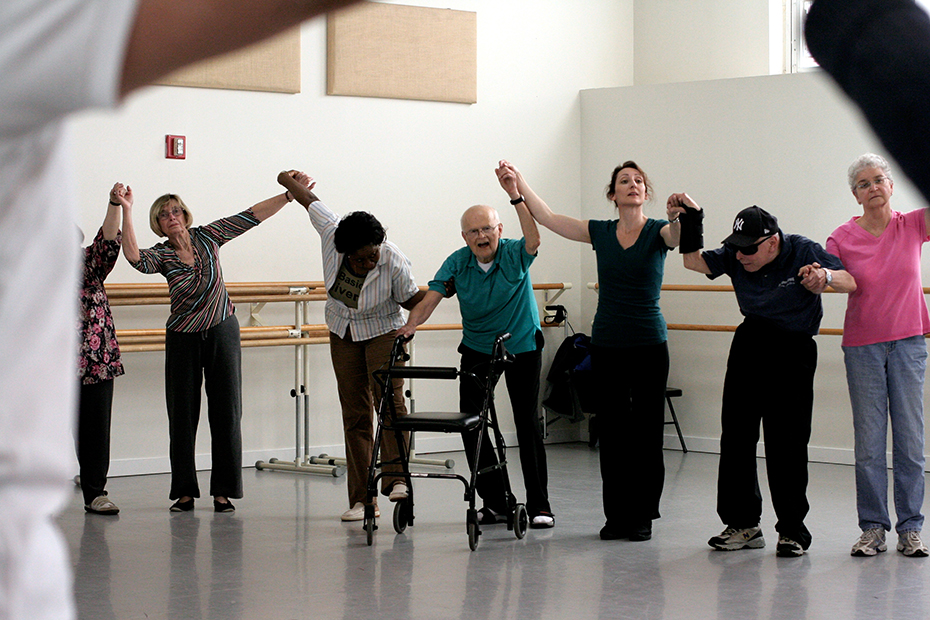
ⓒclass at the Mark Morris Dance Group in Brooklyn, NY.
(Photo: Amber Star Merkens/MMDG. Used by permission).
15년 전 어느 날, 나는 햇살 가득한 댄스 스튜디오에 연상의 브루클린 주민 여섯 분과 둥글게 모여 앉아 있었다. 바깥엔 10월의 날카로운 돌풍이 플랫부시 애비뉴와 라파예트 애비뉴가 교차하는 길모퉁이에 낙엽과 신문 쪼가리를 날려보내고 있었고, 스튜디오 안에서 시계가 2시를 알리자 내 심장은 요동치기 시작했다. 그 날은 파킨슨병 환자들에게 춤을 가르치기로 한 첫 시간이었고, 어떻게 하면 좋을지 아무 생각도 나지 않았다.
지역 내 협력 단체였던 브루클린 파킨슨 그룹(Brooklyn Parkinson Group)의 설립자이자 우리 프로그램의 선구자인 올리 웨스트하이머(Olie Westheimer)는 2001년에 지원 모임을 대상의 무용 강좌를 만들고 싶다며 마크 모리스 댄스 그룹(MMDG, Mark Morris Dance Group)에 연락을 해왔다. 치료 요법으로서가 아니라, 무용의 기술적, 예술적 측면에 초점을 맞추는 전문 무용 강습으로 말이다. 올리가 보기에 무용에는 일석이조의 가치가 있었다. 무용은 환자들이 잠시나마 파킨슨병의 손아귀에서 벗어날 수 있게 해줄 뿐만 아니라, 이 병이 야기하는 신체적, 인지적, 사회적, 표현의 문제들을 즐겁고 창조적인 방식으로 대처할 수 있는 방법을 가르쳐줄 수 있다고 보았기 때문이다. 올리의 제안은 시의적절하기도 했다. MMDG는 브루클린에 마침 무용 센터를 세운 참이었으며 새로 만나게 된 지역 사회의 모든 구성원들 중 특히 수준 높은 무용에 접근할 수 있는 기회가 자연스럽지 않았던 환경의 사람들에게 그 문을 활짝 열고자 했다.
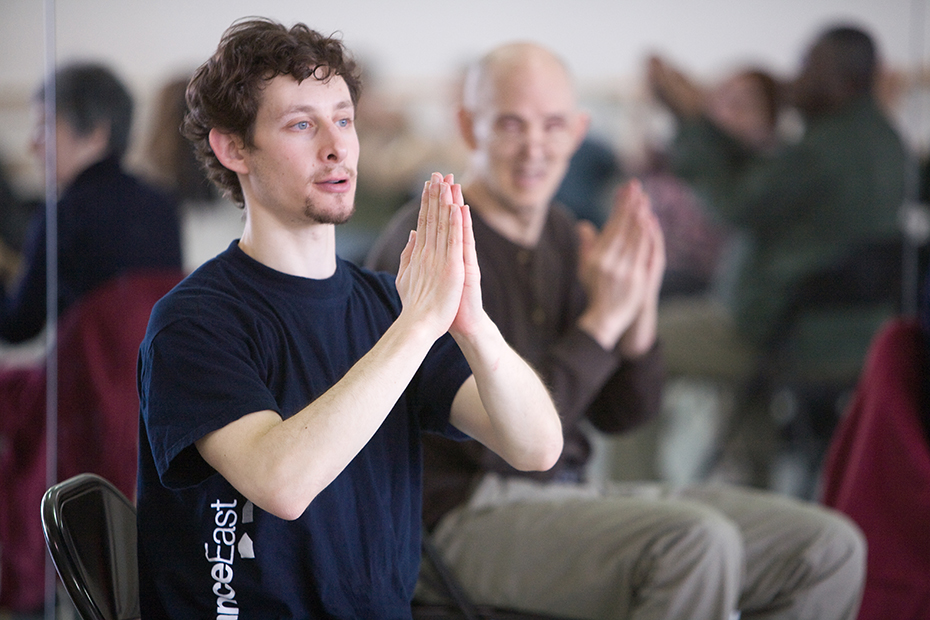
ⓒclass at the Mark Morris Dance Group in Brooklyn, NY.
(Photo: Rosalie O'Connor/MMDG. Used by permission)
무용단은 나의 동료 존 헤긴보텀(John Heginbotham)과 나를 강사로 선택했다. 우린 가르치는 일을 사랑했으며 온갖 다양한 무용수들과 마크 모리스의 레퍼토리를 함께하고 싶어했기 때문이다. 하지만 운동장애가 있는 사람들과 함께 작업해본 경험은 둘 중 어느 누구에게도 없었다. 단지 파킨슨병은 몸이 굳어가고, 움직임이 느려지고, 떨리고, 자세가 불안정해지는 신경퇴행성 질병이라는 기본적인 수준의 이해가 있었을 뿐이었다. 하지만 올리는 첫 회의에서부터 파킨슨병이 아닌 춤에 집중하면 된다고 우리를 격려해 주었고, 그런 점에서 우린 춤에 대해서는 자신이 있었다. 나는 여덟 살 때부터 보스턴 발레단에서 교육을 받았고 대학에서 현대무용으로 폭을 넓혔으며, 마크 모리스 무용단에선 5년차에 접어든 참이었다. 존은 줄리어드에서 공부했으며 나보다 몇 년 더 일찍 마크 모리스 무용단에 합류했었다.
우리는 2시 5분에 호흡과 느린 폴 드 브라(port de bras)로 수업을 시작했다. 그리고 팔로 가벼운 제1, 제2, 제5 포지션을 취하고 발로 탄듀(tendues) 동작도 해보고 나서, 이름 익히기 게임을 하면서 한바탕 웃은 뒤에, 마크 모리스 레퍼토리 중 한 파트를 시도해 보았다. 그리고 시계를 올려다보자 발레 인사로 마무리를 할 시간이었다. 이 인사가 나는 사람들이 둥글게 서서 한 바퀴 파도를 타며 가볍게 절을 하는 것으로 보였다. 수업이 끝난 후 이 잠시 동안의 경험이 참여한 모든 사람들에게 정말 대단한 것이었다고 느꼈지만, 우리가 모두의 삶을 새로운 방향으로 이끌어갈 일을 벌였다는 것은 아직 몰랐다. 그 후 몇 년에 걸쳐 나의 동료들과 나는 웨스트하이머와 그녀의 지원 모임의 도움과 지지에 힘입어, 한 달에 한 번, 수강생 여덟 명으로 시작했던 무용 교실을 주마다 50명 이상이 함께하는 수업으로 성장시켰다. 댄스 포 피디(Dance for PD, Parkinson's Disease)의 탄생이었다.
파킨슨병 환자들과 함께 무용을 한다는 생각을 우리가 처음 한 것은 아니었다. 하지만 파킨슨병 환자들에게 무용의 가치를 알리는 국제 홍보 대사의 역할을 수행한 것은 우리가 첫 번째였고, 상당한 성취 기록과 세계적으로 명성 있는 무용 단체 내부에 기반을 두고 그 역량을 활용해 강습을 진행한 것도 우리가 처음이었다.
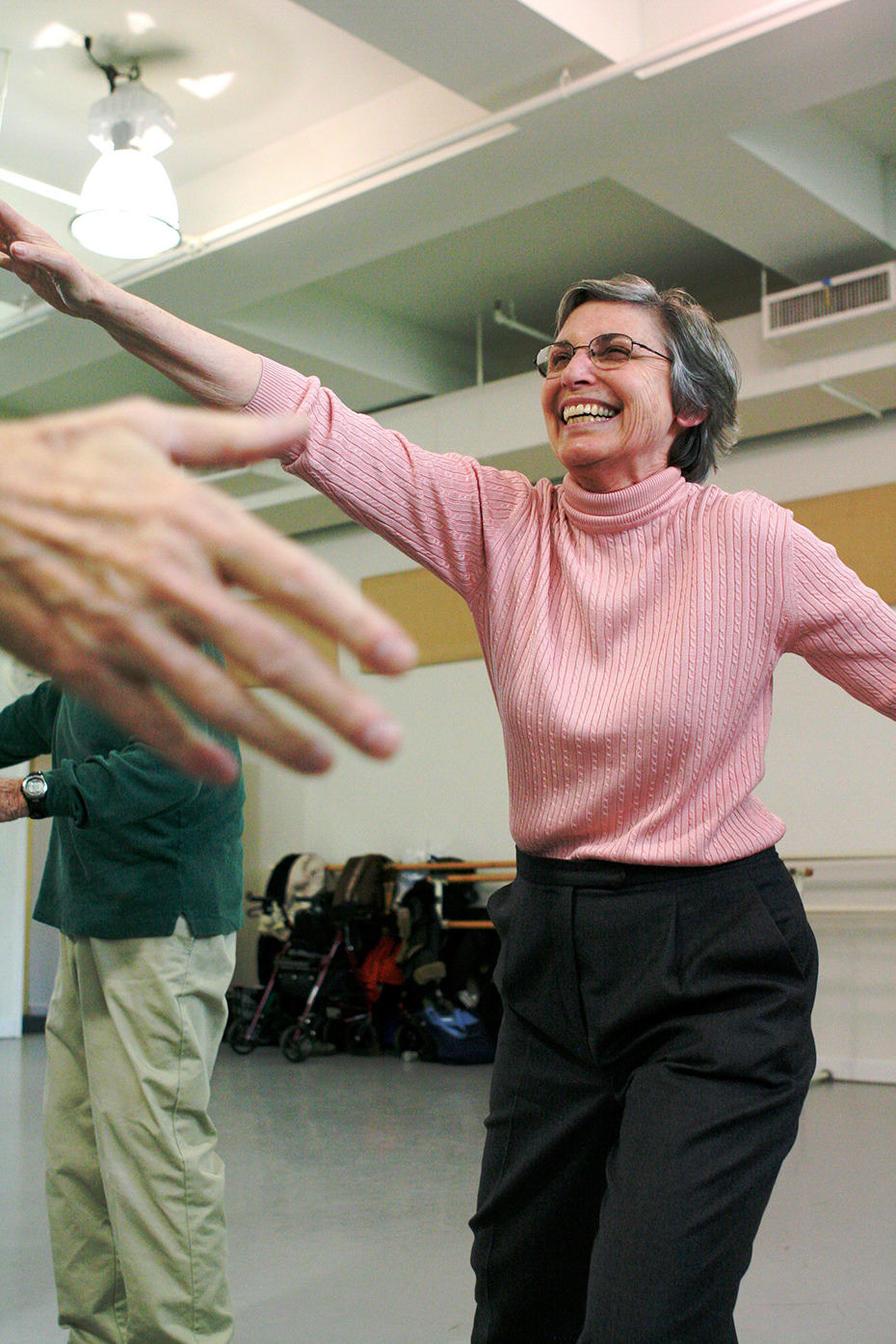
ⓒclass at the Mark Morris Dance Group in Brooklyn, NY.
(Photo: Amber Star Merkens/MMDG. Used by permission).
오늘날에도 댄스 포 피디 프로그램은 MMDG의 주요한 부분으로 남아 있으며, 애초에 기획했던 것보다 기하급수적인 규모로 확대되었다. 우리 모델에 기반한 수업이 전 세계 17개국, 125개 지역 사회에서 진행되고 있다. 전국 뉴스는 물론이고 해외 뉴스에서도 소개되었으며, 선구적인 접근 방식을 인정받아 지역, 국가, 국제단위의 상도 여럿 수상했다. 또한 강습에 대한 접근성을 높이기 위해 앳 홈DVD 시리즈와 스트리밍 생중계 프로그램을 만들었고, 무빙 스루 글래스(Moving Through Glass) 라는 혁신적인 시범 프로젝트도 개시했다. 무빙 스루 글래스는 구글 글래스 플랫폼을 활용해 파킨슨병 환자들에게 무용에 기반한 도구를 제공하는 기획이다. 우리는 퍼스에서 마드리드, 로스앤젤레스에 이르기까지 전 세계 다양한 지역에서 무용 강사, 움직임 지도자, 치료사들을 대상으로 70회 이상의 교육 워크숍을 진행하기도 했다.
댄스 포 피디가 본거지인 브루클린을 벗어나 세계로 뻗어나간 지금도 우리의 모델 자체는 변하지 않았다. 댄스 포 피디에서 강습하는 아티스트들은 현대무용, 발레, 탭 댄스, 포크 댄스, 사교 댄스, 그리고 안무 작품 레퍼토리에서 가져온 움직임을 활용해 참가자가 몸과 마음으로 몰입할 수 있도록 하고 예술적 탐구를 위한 즐겁고 사교적인 환경을 창조한다. 댄스 포 피디는 치료 요법으로서의 동작이 아니라, 무용의 미적인 움직임에 초점을 맞춘다. 또한, 우리 수업은 빈틈없는 강습뿐만 아니라, 참가자들이 지역 사회의 다른 구성원들과 상호작용하고, 긍정적이며 자극이 되는 활동을 파트너와 함께할 수 있는 열린 분위기를 제공하기 위해 힘쓴다.
미국, 영국, 일본, 독일, 호주에서 학계의 검증을 받은 연구 결과에 따르면 걷기 기능 및 단기 이동 능력의 향상, 쇠약 증상 감소, 안정성 증가, 삶의 질 개선 등의 효과가 있다고 한다. 참가자들은 강습을 통해 자신감이 증가했으며 만성 질환을 안고 살아가는 것에 대한 태도가 변화했고, 파킨슨병으로 생기는 몇 가지 운동 장애 증상을 다스리는 데 도움을 받았다고 이야기한다. 무용 수업에서 동료들과 형성하는 긴밀한 관계와 꾸준한 상호작용을 통해 사회적 고립감이나 우울증에 맞서 싸우는 데에도 도움이 될 뿐만 아니라, 환자들이 신체적 가능성과 예술적 성취감을 느끼며 더 힘을 받을 수 있도록 해주기도 한다. 캘리포니아에 사는 어느 참가자가 이야기한 것처럼, "사람을 배제시키고 폐색감과 무력감을 악화시키는 것이 파킨슨병이다. 표현, 증명, 드라마, 움직임과 생동감을 불러오는 것이 춤이다."
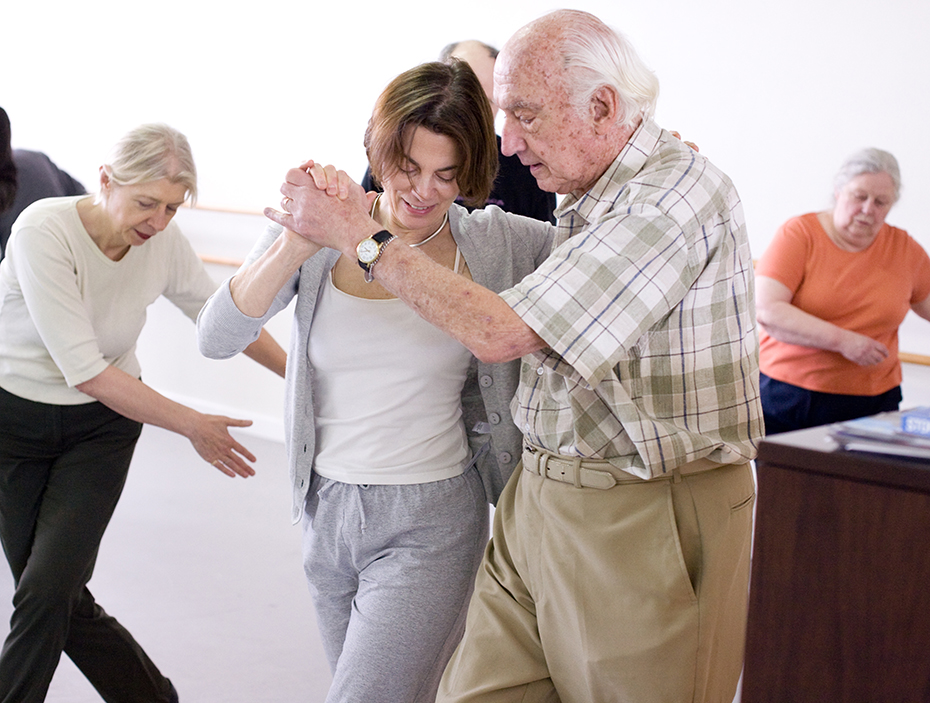
ⓒclass at the Mark Morris Dance Group in Brooklyn, NY.
(Photo: Rosalie O'Connor/MMDG. Used by permission)
파킨슨병은 전통적으로 이동장애로 분류된다. 파킨슨병 환자들은 한때 자동적으로 행하던 동작을 안정적으로 해낼 수 없게 되며, 혼란스럽고, 느리고, 떨리고, 뻣뻣한 움직임을 보이게 되는 경우가 많다. 안무를 처음으로 익히는 무용가들이 그렇듯이, 파킨슨병 환자들은 걷기, 돌기, 멈추기처럼 무의식적으로 해내던 움직임들을, 의식적인 마음으로 집중해야만 하는 낯선 동작으로 새롭게 받아들여야 한다. 삶의 안무를 다시 배워야 하는 것이다. 무용 교습은-그리고 이미지, 음악, 연속 동작과 서사 등의 구체적인 요소들은-파킨슨병 환자들에게 예전처럼 잘 되지 않는 동작들을 의식적으로 다시 정리할 수 있는 동작 제어 수단을 제공하여, 신체적 자기 통제력을 되찾아준다. 많은 참가자들은 이 점이 큰 힘이 된다고 말한다.
한 팔을 앞으로 뻗는 간단한 행위를 예로 들어보자. 물리 치료 시간이라면, 시술자는 기계적인 측면들에 주의를 쏟을 것이다. 어떤 근육을 써야 하는지, 가동 범위는 어떤지, 환자가 구체적인 목표치를 달성했는지. 반면 무용 수업에선 상상력을 통해 알리고, 재교육하고, 동기를 부여한다. '방 안의 저 사람을 향해 팔을 뻗어보겠어요? 하늘의 별을 따보겠어요? 오페라 하우스의 위층 발코니석을 향해 인사를 한다고 생각해 보겠어요? 그러면 어떤 느낌으로 팔을 뻗어야 할까요?' 이처럼 움직임에 있어 기계적 요소가 아닌 미적 요소에 집중함으로써 파킨슨병 환자들은 무용가처럼 생각하는 법을 배우기 시작한다. 환자들은 무용의 바탕이 되는, 신체를 의식적으로 제어한다는 감각을 배우고, 잠시 동안만이라도 몸에 새길 수 있다. 무용가들이 균형, 협력, 움직임의 시발점, 역학, 증폭 등의 개념을 체화시키기 위해 활용하는 전략들이, 질병에 무너져 유연성과 리듬을 갖추기 어려운 신체를 다시 제어하려는 환자들의 싸움에 긴요한 도구로 완벽하게 전용될 수 있다는 사실은 15년이 지난 지금에도 놀랍게 느껴진다.
우리의 참가자들이 신체를 제어하기 위한 싸움에서 경험하는 승리감은 신체적인 것에 그치지 않는다. 그들은 춤을 통해 어떤 질환의 환자라는 정체성을 거부하고, 크고 또렷하게 "나는 무용가다"라고 말할 수 있는 기회를 얻는 것이다.
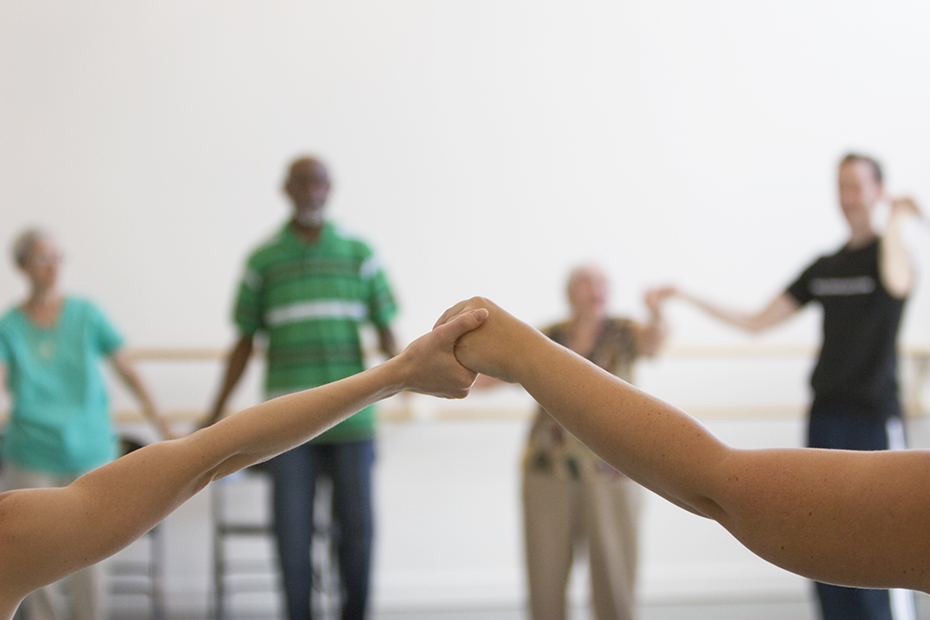
ⓒclass at the Mark Morris Dance Group in Brooklyn, NY.
(Photo: Johan Henckens/MMDG. Used by permission).
번역: 정수혁
데이비드 레벤탈(David Leventhal)
댄스 포 피디 프로그램의 창립 강사이자 프로그램 디렉터이다. 댄스 포 피디는 마크 모리스 댄스 그룹(MMDG, Mark Morris Dance Group)에서 제공하는 세계적으로 호평받은 프로그램으로서, 전세계 17개국의 140개 지역 사회에서 파킨슨병 환자를 대상으로 한 무용 교육 프로그램의 모델이 되고 있다. 레벤탈은 1997년에서 2011년까지 MMDG에서 수석무용수로 공연했으며 2010년 베시상(New York Dance and Performance Award) 공로상을 수상했다.
(재)전문무용수지원센터
재)전문무용수지원센터(이하 센터)는 2017년 마크모리스 무용단의 Dance for PD 강사 양성 프로그램을 국내에서 최초로 도입하여 국내 전문무용수를 대상으로 강사 양성 및 파견 사업을 추진한다. 센터는 지난 1월 Dance for PD 강사 양성 사업에 참여를 희망하는 전문 무용수들을 모집했으며 선정된 무용수들은 현재 강사 양성 교육 프로그램을 밟고 있다. 또한 2017년 9월 1일부터 3일까지 3일 간 센터가 추진하는 '2017 심포지엄'과 'Dance for PD 워크숍' 통해 Dance for PD를 국내에 소개할 계획이다.
Dancers, not patients:
How a global program empowers people with Parkinson's transform their minds, bodies and lives through dance
David Leventhal_ Founding teacher, Program Director for Dance for PD
15 years ago, I found myself seated in a circle with six older Brooklynites in a sun-filled dance studio. Outside, crisp October gusts blew leaves and newspapers around the corner of Flatbush and Lafayette Avenues. Inside, the clock struck 2 and my heart raced. I was scheduled to teach my first dance class to people with Parkinson's, and I had no idea what I was doing.
Westheimer, the visionary behind the program and the founder of our community partner, the Brooklyn Parkinson Group, approached Mark Morris Dance Group (MMDG) in 2001 with the idea for a dance class for her support group-not a therapy session, but a class that focused on the art and craft of dancing. In Olie's mind, dance was a double-edged sword: it might allow people to temporarily escape from their Parkinson's world while providing an enjoyable, creative way to address the physical, cognitive, social and expressive challenges of the condition. Olie's idea arrived at the right time-MMDG had just built a brand new dance center in Brooklyn and was eager to open its doors to all members of its new community, particularly those who might not naturally have access to high quality dance experiences.
company chose my colleague John Heginbotham and me to teach because we had a passion for teaching, and we loved sharing Mark's repertory with all sorts of dancers-but neither of us had any experience working with people living with a movement disorder. We just had a basic understanding that Parkinson's was a neurodegenerative disorder causing rigidity, slowness, tremor and postural instability. From the first conversation, Olie encouraged us to focus on the dancing, not the Parkinson's, and we did know something about dancing. I trained at Boston Ballet from age eight, expanded into modern dance at university, and was starting my fifth year dancing in Mark Morris' company. John was Juilliard-trained, and started performing with MMDG a few years before I did.
2:05, we started class with breathing and slow port de bras. We floated through first, second and fifth positions of the arms, steered our tendues out and in, laughed our way through a name game, and explored a section of Mark Morris repertory. By the time I looked up at the clock, it was time for a reverence, which I reinterpreted as a passing of a pulse and bow around the circle. When class was done, I realized the momentary significance of that experience for everyone involved, but had no idea that we had done something that was to chart a new course in all our lives. Over the next few years, my colleagues and I, with the support and guidance of Westheimer and her support group, built a single monthly class for eight people into a weekly class with more than 50. Dance for PD (Dance for Parkinson's Disease) was born.
weren't the first to introduce the idea of dance to people with Parkinson's. But we were the first to take on the role of international ambassadors for the value of dance for the Parkinson's community, and to root and source our teaching work within an internationally-respected dance organization with an impressive footprint.
Today, the Dance for PDㄾ program is still a vital part of the Mark Morris Dance Group, but it has developed a scope exponentially broader than originally planned. There are classes based on our model in more than 125 communities in 17 countries around the world. We've been featured on national and international news networks, and we've won several local, national and international awards for our pioneering approach. We've worked to make our classes more accessible through an At Home DVD series, live streaming initiative and an innovative pilot project called Moving Through Glass, which offers people with Parkinson's a dance-based toolkit on the Google Glass platform. We've offered more than 70 training workshops for dance instructors, movement teachers, and therapists around the globe, from Perth to Madrid to Los Angeles, and everywhere in between.
As Dance for PD has grown beyond our Brooklyn home, our model remains the same. Dance for PD teaching artists integrate movement from modern, ballet, tap, folk and social dancing, and choreographic repertory to engage participants' minds and bodies and create an enjoyable, social environment for artistic exploration. Dance for PD focuses on the aesthetic movement of dance rather than acting as therapy. In addition to rigorous training, Dance for PD classes provide a social environment for participants to interact with other community members, and to share a positive, stimulating activity together with their partners. reviewed research studies in the United States, United Kingdom, Japan, Germany and Australia point to benefits that include improved walking and short-term mobility, reduction in debilitating symptoms, improved stability, and improvements in quality of life. Participants report that the classes boost their confidence levels, transform their attitudes about living with a chronic illness, and help them manage some of the motor symptoms associated with Parkinson's disease. Consistent interaction within the close-knit community of the dance class helps to combat social isolation and depression while empowering participants with a sense of physical possibility and artistic achievement. As one California-based participant noted, "If there is anything that sidelines you, exacerbates your sense of constriction and inhibition it is Parkinson's. If there is anything that calls for expression, demonstration, drama, movement, expression and liveliness it is dance." 's is traditionally classified as a movement disorder. In people with Parkinson's, movement that was once automatic is no longer reliable and often appears disorganized, slowed down, tremulous, or rigid. As dancers do when they're learning choreography for the first time, people with Parkinson's must understand movements they once did automatically-walking, turning, stopping-as new movements that require the dedicated focus of their conscious minds. They must relearn the choreography of life. Dance training-and the specific elements of imagery, music, sequencing and narrative-offer people with Parkinson's a motor control toolkit that helps them consciously re-order movements that aren't working as well, providing a sense of physical control that many participants find empowering. the simple act of reaching an arm forward. In a physical therapy session, the practitioner might focus on mechanical cues-which muscles to use, the range of motion, and whether someone has met a specific target. In dance class, we use the imagination to inform, retrain and motivate. Can you reach toward someone in the room, grab a star out of the sky, or think about bowing to the upper balcony in an opera house? And what movement quality should you use to perform that reach? By focusing on the aesthetics of movement, rather than mechanics, people with Parkinson's can start to think like dancers. They can learn and embody, at least temporarily, the sense of mindful physical control on which dancers rely. Even after 15 years, I find it remarkable that the exact strategies that dancers use to embody balance, coordination, initiation, dynamics and amplitude translate so perfectly to become vital tools in a battle to maintain control over dis-ordered bodies that struggle to find fluidity and rhythm.the battle for control, participants experience a victory that goes beyond the purely physical-through dance, they are offered a chance to reject their identity as patients with a medical condition and to say, loudly and clearly, "I am a dancer.“
15 years ago, I found myself seated in a circle with six older Brooklynites in a sun-filled dance studio. Outside, crisp October gusts blew leaves and newspapers around the corner of Flatbush and Lafayette Avenues. Inside, the clock struck 2 and my heart raced. I was scheduled to teach my first dance class to people with Parkinson's, and I had no idea what I was doing.
Westheimer, the visionary behind the program and the founder of our community partner, the Brooklyn Parkinson Group, approached Mark Morris Dance Group (MMDG) in 2001 with the idea for a dance class for her support group-not a therapy session, but a class that focused on the art and craft of dancing. In Olie's mind, dance was a double-edged sword: it might allow people to temporarily escape from their Parkinson's world while providing an enjoyable, creative way to address the physical, cognitive, social and expressive challenges of the condition. Olie's idea arrived at the right time-MMDG had just built a brand new dance center in Brooklyn and was eager to open its doors to all members of its new community, particularly those who might not naturally have access to high quality dance experiences.
company chose my colleague John Heginbotham and me to teach because we had a passion for teaching, and we loved sharing Mark's repertory with all sorts of dancers-but neither of us had any experience working with people living with a movement disorder. We just had a basic understanding that Parkinson's was a neurodegenerative disorder causing rigidity, slowness, tremor and postural instability. From the first conversation, Olie encouraged us to focus on the dancing, not the Parkinson's, and we did know something about dancing. I trained at Boston Ballet from age eight, expanded into modern dance at university, and was starting my fifth year dancing in Mark Morris' company. John was Juilliard-trained, and started performing with MMDG a few years before I did.
2:05, we started class with breathing and slow port de bras. We floated through first, second and fifth positions of the arms, steered our tendues out and in, laughed our way through a name game, and explored a section of Mark Morris repertory. By the time I looked up at the clock, it was time for a reverence, which I reinterpreted as a passing of a pulse and bow around the circle. When class was done, I realized the momentary significance of that experience for everyone involved, but had no idea that we had done something that was to chart a new course in all our lives. Over the next few years, my colleagues and I, with the support and guidance of Westheimer and her support group, built a single monthly class for eight people into a weekly class with more than 50. Dance for PD (Dance for Parkinson's Disease) was born.
weren't the first to introduce the idea of dance to people with Parkinson's. But we were the first to take on the role of international ambassadors for the value of dance for the Parkinson's community, and to root and source our teaching work within an internationally-respected dance organization with an impressive footprint.
Today, the Dance for PDㄾ program is still a vital part of the Mark Morris Dance Group, but it has developed a scope exponentially broader than originally planned. There are classes based on our model in more than 125 communities in 17 countries around the world. We've been featured on national and international news networks, and we've won several local, national and international awards for our pioneering approach. We've worked to make our classes more accessible through an At Home DVD series, live streaming initiative and an innovative pilot project called Moving Through Glass, which offers people with Parkinson's a dance-based toolkit on the Google Glass platform. We've offered more than 70 training workshops for dance instructors, movement teachers, and therapists around the globe, from Perth to Madrid to Los Angeles, and everywhere in between.
As Dance for PD has grown beyond our Brooklyn home, our model remains the same. Dance for PD teaching artists integrate movement from modern, ballet, tap, folk and social dancing, and choreographic repertory to engage participants' minds and bodies and create an enjoyable, social environment for artistic exploration. Dance for PD focuses on the aesthetic movement of dance rather than acting as therapy. In addition to rigorous training, Dance for PD classes provide a social environment for participants to interact with other community members, and to share a positive, stimulating activity together with their partners. reviewed research studies in the United States, United Kingdom, Japan, Germany and Australia point to benefits that include improved walking and short-term mobility, reduction in debilitating symptoms, improved stability, and improvements in quality of life. Participants report that the classes boost their confidence levels, transform their attitudes about living with a chronic illness, and help them manage some of the motor symptoms associated with Parkinson's disease. Consistent interaction within the close-knit community of the dance class helps to combat social isolation and depression while empowering participants with a sense of physical possibility and artistic achievement. As one California-based participant noted, "If there is anything that sidelines you, exacerbates your sense of constriction and inhibition it is Parkinson's. If there is anything that calls for expression, demonstration, drama, movement, expression and liveliness it is dance." 's is traditionally classified as a movement disorder. In people with Parkinson's, movement that was once automatic is no longer reliable and often appears disorganized, slowed down, tremulous, or rigid. As dancers do when they're learning choreography for the first time, people with Parkinson's must understand movements they once did automatically-walking, turning, stopping-as new movements that require the dedicated focus of their conscious minds. They must relearn the choreography of life. Dance training-and the specific elements of imagery, music, sequencing and narrative-offer people with Parkinson's a motor control toolkit that helps them consciously re-order movements that aren't working as well, providing a sense of physical control that many participants find empowering. the simple act of reaching an arm forward. In a physical therapy session, the practitioner might focus on mechanical cues-which muscles to use, the range of motion, and whether someone has met a specific target. In dance class, we use the imagination to inform, retrain and motivate. Can you reach toward someone in the room, grab a star out of the sky, or think about bowing to the upper balcony in an opera house? And what movement quality should you use to perform that reach? By focusing on the aesthetics of movement, rather than mechanics, people with Parkinson's can start to think like dancers. They can learn and embody, at least temporarily, the sense of mindful physical control on which dancers rely. Even after 15 years, I find it remarkable that the exact strategies that dancers use to embody balance, coordination, initiation, dynamics and amplitude translate so perfectly to become vital tools in a battle to maintain control over dis-ordered bodies that struggle to find fluidity and rhythm.the battle for control, participants experience a victory that goes beyond the purely physical-through dance, they are offered a chance to reject their identity as patients with a medical condition and to say, loudly and clearly, "I am a dancer.“
David Leventhal_ Founding teacher, Program Director for Dance for PD
David Leventhal is a founding teacher and Program Director for Dance for PDㄾ, an internationally-acclaimed program of the Mark Morris Dance Group (MMDG) that has been used as a model for dance classes for people with Parkinson's in more than 140 communities in 17 countries. From 1997-2011, Leventhal performed principal roles with MMDG, receiving a 2010 Bessie (New York Dance and Performance Award) for career achievement.